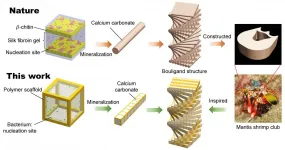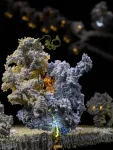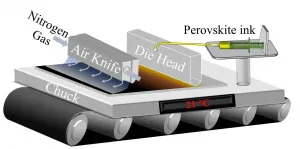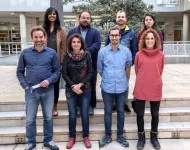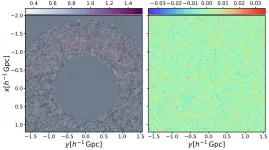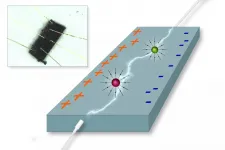(Press-News.org) Biological systems can harness their living cells for growth and regeneration, but engineering systems cannot. Until now.
Qiming Wang and researchers at the USC Viterbi School of Engineering are harnessing living bacteria to create engineering materials that are strong, tolerant, and resilient. The research is published in Advanced Materials.
"The materials we are making are living and self-growing," said Wang, the Stephen Schrank Early Career Chair in Civil and Environmental Engineering and assistant professor of civil and environmental engineering in the Sonny Astani Department of Civil and Environmental Engineering (CEE). "We have been amazed by the sophisticated microstructures of natural materials for centuries, especially after microscopes were invented to observe these tiny structures. Now we take an important step forward: We use living bacteria as a tool to directly grow amazing structures that cannot be made on our own."
The researchers work with specific bacteria-- S. pasteurii--known for secreting an enzyme called urease. When urease is exposed to urea and calcium ions, it produces calcium carbonate, a fundamental and strong mineral compound found in bones or teeth. "The key innovation in our research," said Wang, "is that we guide the bacteria to grow calcium carbonate minerals to achieve ordered microstructures which are similar to those in the natural mineralized composites."
Wang added: "Bacteria know how to save time and energy to do things. They have their own intelligence, and we can harness their smartness to design hybrid materials that are superior to fully synthetic options.
Borrowing inspiration from nature is not new in engineering. As one would suspect, nature has great examples of complex mineralized composites that are strong, fracture resistant, and energy damping--for example nacre or the hard shell surrounding a mollusk.
Wang said: "Although microorganisms such as bacteria, fungi and viri are sometimes detrimental in causing diseases--like COVID-19--they can also be beneficial. We have a long history of using microorganisms as factories--for example, using yeast to make beer. But there is limited research on using microorganisms to manufacture engineering materials."
Combining living bacteria and synthetic materials, Wang said this new living material demonstrates mechanical properties superior to that of any natural or synthetic material currently in use. This is largely due to the material's bouligand structure, which is characterized by multiple layers of minerals laid at varying angles from each other to form a sort of "twist" or helicoidal shape. This structure is difficult to create synthetically.
Wang worked in collaboration with USC Viterbi researchers An Xin, Yipin Su, Minliang Yan, Kunhao Yu, Zhangzhengrong Feng, and Kyung Hoon Lee. Additional support was provided by Lizhi Sun, professor of civil engineering at the University of California, Irvine, and his student Shengwei Feng.
What's in a Shape?
One of the key properties of a mineralized composite, Wang said, is that it can be manipulated to follow different structures or patterns. Researchers long ago observed the ability of a mantis shrimp to use his "hammer" to break open a muscle shell. Looking at his "hammer"--a club-like structure or hand--more closely, they found it was arranged in a bouligand structure. This structure offers superior strength to one arranged at more homogenous angles--for example alternating the lattice structure of the material at 90 degrees with each layer.
"Creating this structure synthetically is very challenging in the field," Wang said. "So we proposed using bacteria to achieve it instead."
In order to build the material, the researchers 3-D printed a lattice structure or scaffolding. This structure has empty squares within it and the lattice layers are laid at varying angles to create scaffolding in line with the helicoidal shape.
The bacteria are then introduced to this structure. Bacteria intrinsically like to attach to surfaces and will gravitate to the scaffolding, grabbing on to the material with their "legs." There the bacteria will secrete urease, the enzyme which triggers formations of calcium carbonate crystals. These grow from the surface up, eventually filling in the tiny squares or voids in the 3-D printed lattice structure. Bacteria like porous surfaces, Wang said, allowing them to create different patterns with the minerals.
The Trifecta
"We did mechanical testing that demonstrated the strength of such structures to be very high. They also were able to resist crack propagation--fractures--and help dampen or dissipate energy within the material," said An Xin, a CEE doctoral student.
Existing materials have shown exceptional strength, fracture resistance, and energy dissipation but the combination of all three elements has not been demonstrated to work as well as in the living materials Wang and his team created.
"We fabricated something very stiff and strong," Wang said. "The immediate implications are for use in infrastructures like aerospace panels and vehicle frames."
The living materials are relatively lightweight, also offering options for defense applications like body armor or vehicle armor. "This material could resist bullet penetration and dissipate energy from its release to avoid damage," said Yipin Su, a postdoc working with Wang.
There's even potential for these materials to be reintroduced to bacteria when repairs are needed.
"An interesting vision is that these living materials still possess self-growing properties," Wang said. "When there is damage to these materials, we can introduce bacteria to grow the materials back. For example, if we use them in a bridge, we can repair damages when needed."
INFORMATION:
An international collaboration among researchers from Finland, Sweden, UK and the USA has captured ribosomes translating messenger RNA expressed from the maternally inherited mitochondrial genome. Utilising the latest advances in cryo-electron microscopy, the group discovered a novel mechanism that mitochondrial ribosomes use for the synthesis and delivery of newly made proteins to prevent premature misfolding. Disruptions to protein folding can lead to devastating human diseases.
There is a familiar saying, "It's all in the genes". As modern archaeology reveals, the DNA that encodes genes can be found among the remnants of our ancestors and from any organism, small and large, that once roamed the earth. The genetic blueprint alone is ...
According to a research conducted by JCDR, at least 9 out of 10 adults suffer from low health literacy in India. Health literacy is a vital aspect of any nation's growth - be it developed, underdeveloped or a developing nation. A team of researchers lead by Ruban Nersisson, at the School of Electrical Engineering, Vellore Institute of Technology, Vellore, India, have written a review on Tinnitus, a disorder of the ear characterized by a ringing sound in one or both of the ears. "We intend to spread awareness of a common hearing disorder which ironically is not commonly known to people.", says Nersisson.
'Tinnitus', is a hearing disorder that has been affecting around 7-8% of the human population since ...
They have improved a process for vertically depositing a solution made from an inexpensive perovskite solute onto a moving substrate below. Not only have they discovered the crucial role played by one of the solvents used, but they have also taken a closer look at the aging and storage properties of the solution.
Solar cells made of crystalline silicon still account for the lion's share of roof installations and solar farms. But other technologies have long since become established as well - such as those that convert sunlight into electrical energy through use of extremely thin layers of solar-cell material deposited upon a substrate. The perovskite solar cells that Prof. Eva Unger and her team at the Helmholtz-Zentrum ...
The regulation of satiety is an important factor that determines a higher or lower intake of energy and, therefore, has a considerable impact on the development and/or progression of obesity. The team made up of the researchers Lucia Camacho Barcia, Jesús García-Gavilán, Christopher Papandreou, and Mònica Bulló that leads the research group in Nutrition and Metabolic Diseases of the Department of Biochemistry and Biotechnology (Universitat Rovira i Virgili - Tarragona-Spain) have worked with researchers from Denmark ...
Long-term sleep deprivation is detrimental to health, increasing the risk of psychiatric and somatic disorders, such as depression and cardiovascular diseases. And yet, little is known about the molecular biological mechanisms set in motion by sleep deprivation which underlie related adverse health effects.
In a recently published study, the University of Helsinki, the Finnish Institute for Health and Welfare, the Finnish Institute of Occupational Health and the Finnair airline investigated dynamic changes to DNA methylation in shift workers. DNA methylation denotes epigenetic regulation that modifies gene function and regulates gene activity without changing the sequence of bases in the DNA.
Short-term genetic changes caused by DNA methylation are not well known. While ...
Physicists from Switzerland, Germany and Ukraine have proposed an innovative new data storage medium. The technique is based on specific properties of antiferromagnetic materials that had previously resisted experimental examination.
Using nanoscale quantum sensors, an international research team has succeeded in exploring certain previously uncharted physical properties of an antiferromagnetic material. Based on their results, the researchers developed a concept for a new storage medium published in the journal Nature Physics. The project was coordinated by researchers from the Department of Physics and the Swiss Nanoscience Institute at the University of Basel.
Antiferromagnets make up 90 percent of all magnetically ordered materials. Unlike ferromagnets such as iron, ...
Using laws governing human rights may be the best way of harnessing international legislation and tribunals to protect the Amazon, a new study shows.
Safeguarding the rainforest is a critical priority because of the ecosystem's planetary importance. Recent increases in deforestation and fires in the region have made this even more urgent.
The new research, published in the Review of European, Comparative and International Environmental Law (RECIEL), says using human rights law to protect the Amazon is more likely to have stronger prospects, as campaigners wouldn't need to submit information about more than one nation for it to be upheld. Courts would only need to judge that environmental damage violated the rights of either certain individuals or tribal and indigenous peoples.
The ...
The Instituto de Astrofísica de Canarias (IAC) has led an international team which has developed an algorithm called COSMIC BIRTH to analyse large scale cosmic structures. This new computation method will permit the analysis of the evolution of the structure of dark matter from the early universe until the formation of present day galaxies. This work was recently published in the journal Monthly Notices of the Royal Astronomical Society (MNRAS).
The IAC researcher, a co-author of the article and leader of the group of Cosmology and Large Scale Structure (LSS) Francisco-Shu Kitaura explains that one of the key aspects of this algorithm "consists in expressing the observations as if they had been detected in the early universe, which ...
Moralities of Intelligent Machines is a project that investigates people's attitudes towards moral choices made by artificial intelligence. In the latest study completed under the project, study participants read short narratives where either a robot, a somewhat humanoid robot known as iRobot, a robot with a strong humanoid appearance called iClooney or a human being encounters a moral problem along the lines of the trolley dilemma, making a specific decision. The participants were also shown images of these agents, after which they assessed the morality of their decisions. The study was funded by the Jane and Aatos Erkko Foundation and the Academy of Finland.
The trolley dilemma is a problem ...
Electric current is deflected by a magnetic field - in conducting materials this leads to the so-called Hall effect. This effect is often used to measure magnetic fields. A surprising discovery has now been made at TU Wien, in collaboration with scientists from the Paul Scherrer Institute (Switzerland), McMater University (Canada), and Rice University (USA): an exotic metal made of cerium, bismuth and palladium was examined and a giant Hall effect was found to be produced by the material, in the total absence of any magnetic field. The reason for this unexpected result lies in the unusual properties of the electrons: They behave as if magnetic ...
